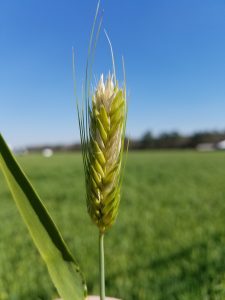Andrew Kness, Extension Educator, Harford County

It might seem odd reading an article about frost and freeze to grain crops in the June issue of this newsletter, but we had a fairly widespread frost event in northern Maryland during the second week of May. As a result, I have been contacted by some growers asking about the susceptibility of grain crops to a late freeze. The main concern with a May frost is in small grains and soybeans. Early frost damage to corn almost never limits yield unless the frost is accompanied by extended exposure to lethal temperatures (>3 hours exposure to 28°F for corn).
When we talk about frost and freeze injury in plants we’re really only concerned about the damage to two organ/tissue types; buds and flowers. If you lose all vegetative bud(s) or growing points that support new growth, the plant will die. Different plants have different abilities to recover from freeze damage, largely because of their germination process. For example, peas are a frost-hardy crop that can be planted before the frost-free date, whereas soybeans and snap beans should be planted after the risk for frost has passed or has significantly reduced. But why is that? They are closely related plants, yet their tolerance to frost and freeze is vastly different.
The reason being lies in the fact that the two plants have two opposing germination processes, which determines where the first bud is in relation to the soil. In dicots, the first bud is located just above the cotyledons (seed leaves). Subsequent buds are located up the plant where leaves meet the stem. These are called axillary buds. If injury occurs to a part of the plant that causes tissue death (ex: a hard freeze), it will regrow from the next un-injured axillary bud closest to the injured tissue. However, if all the tissues are damaged, including the first bud (just above the cotyledons), the plant has no buds to sprout re-growth and will die.
Going back to the example of the pea vs. bean; the pea plant has hypogeal germination, which is a germination process that keeps the cotyledons below the soil line and therefore the first bud is insulated by the soil from freezing temperatures. So even if all the above-ground parts of the pea plant are killed by frost or freeze, the plant has a protected bud beneath the soil surface ready to grow. Conversely, beans have epigeal germination, a process by which the cotyledons emerge above the soil line, and therefore expose the first bud to the elements and potential freeze and frost damage. This is why soybeans and snap beans (and all other plants that have epigeal germination) are much more susceptible to freezing temperatures.
Similarly to peas, the main growing point in corn remains underground until the corn reaches V5, or approximately 10-12” tall, protecting the plant from fatal freeze damage. Frost damage before V5 is mostly cosmetic and plants will typically grow out of it with no loss in yield.
As mentioned earlier, the second organ type that we are concerned about when talking about frost and freeze, are flowers. Frost damage to flowers can result in incomplete fertilization and grain fill, therefore significantly affecting yield. Small grains are resistant to frost and freeze injury up until they begin to joint when the growing point, which ultimately becomes the flowers and head, breaks the soil surface. Freeze damage and leaf burn from frost prior to jointing (Feekes 6) is mostly cosmetic and plants will grow out of it as long as sufficient nitrogen is present. Your topdress nitrogen application at jointing should provide sufficient nitrogen to combat any foliar frost injury. Small grains are most susceptible to freeze injury from boot through flowering (Feekes 6-10). The pollen-producing structures (anthers) are the most susceptible part of the flower to freeze injury.
Research has shown that wheat can tolerate temperatures as low at 28°F during boot, but only 30°F during flowering. Barley is more susceptible to freeze injury during the boot than wheat because barley flowers while in boot. Susceptibility to freeze injury in small grains drops slightly (back to 28°F) once fertilization occurs and grain fill begins. A few weeks ago when we had frost in northern Maryland, many locations saw low temperatures around 34°F. The severity of frost and freeze damage is not only a function of temperature, but also exposure time. Exposure to the critical temperatures listed above for more than two hours in small grains can result in severe yield loss. Luckily our freeze event was only an hour long in most areas. Furthermore, we were also fortunate with the timing of the event, as barley was past flowering and wheat was not yet flowering.
For more information, University of Nebraska has an excellent publication covering freeze injury to winter wheat: http://extensionpublications.unl.edu/assets/pdf/ec132.pdf
